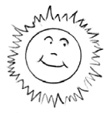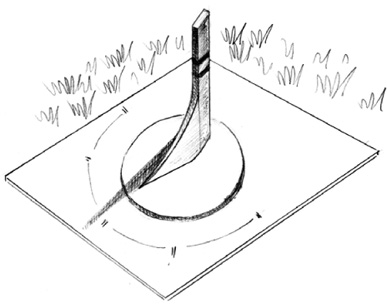
A sundial can be useful even if the sun isn’t shining. As a snow depth gauge, it will tell you how much work is required to shovel off the pond for the next hockey game. Your sundial / snow depth gauge might even be buried in snow up to the wagungas. But knowing how high up your wagungas are makes for easy calibration. Sunlight gets scarce in the winter, and you probably won’t be running out to see what time it is when it’s 30 below anyway. It’s time to be inside, carving and sanding that beautiful sundial gizmo.
Carve an elegant spire, handsomely crafted from a hockey stick with the care that only somebody with too much time on his hands can give. The needle of the sundial needs to come to a nice point. You also need a dial. This need not be a full circle because the sun isn’t available to cast a shadow around a full circle anyway unless you live where you regularly catch Arctic char and have to watch your back for polar bears when you go to the dump. And while you are at the dump, why not look for a wall clock that is fixable and just give your sundial contraption to that bear to use as a toothpick.
The sundial will not give you a very precise time, but you will get readings to within the hour. “Setting” your sundial will have to be done over a period of a whole year. Here’s how. Those of us who are up to see the sun rise observe that the point at which it creeps over the horizon changes dramatically between summer and winter. These points are most divergent at the solstices, and the mid-point occurs at the spring and autumnal equinoxes. Take your readings at the equinox. This will give you an average of shadow positions for the rest of the year. Get a circle of cardboard and place the stick vertically in the centre. Draw a line along the centre of the stick’s shadow at each increment of time you wish to be able to read: 6 AM, noon, 6 PM, whatever times you like. You can transfer this information to the permanent base that you’ll make for your sundial.
For that, how about “borrowing” a hubcap from a meddlesome neighbor’s car? Fill the inside with concrete, and, as it hardens, put a bolt in the centre with the threads facing up. Place odd bits of hockey sticks in the cement (or draw in it with a stick), copying the shadow increments you recorded at the equinox. Pre-drill up the center of the bottom of hockey stick, and when the cement hardens, screw it down onto the base. Make sure you place your masterpiece with the same orienation as when you took the original readings. And, remember the hubcap appropriation if you ever have that neighbour over for a garden party.

